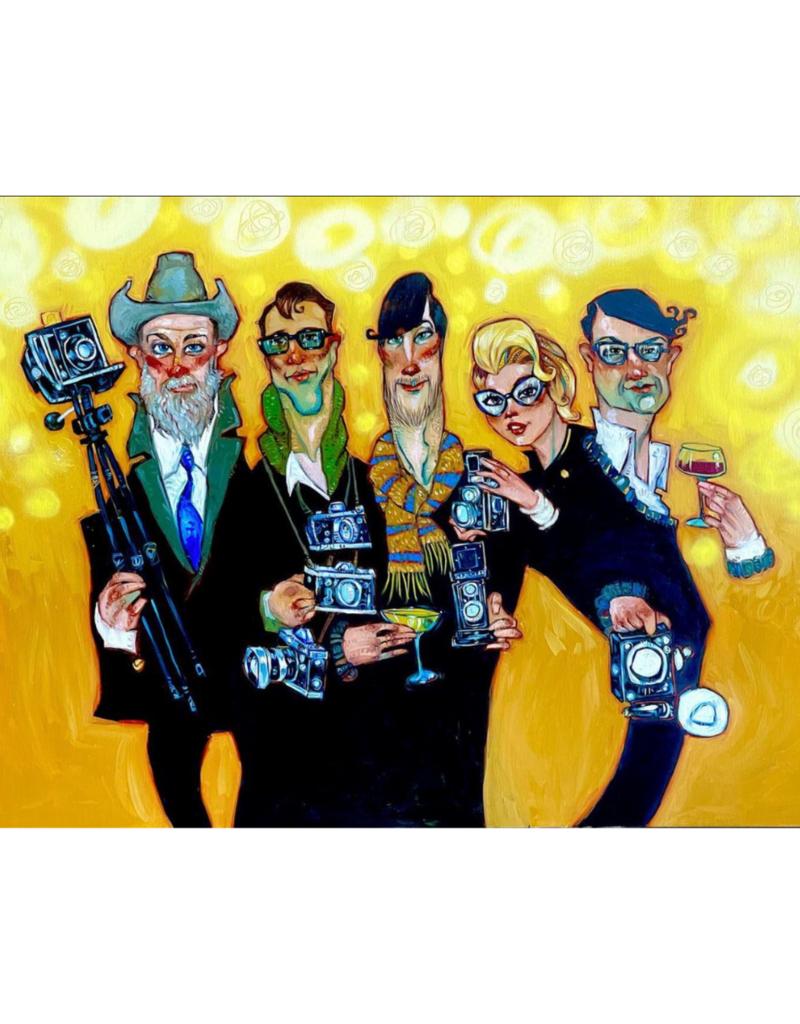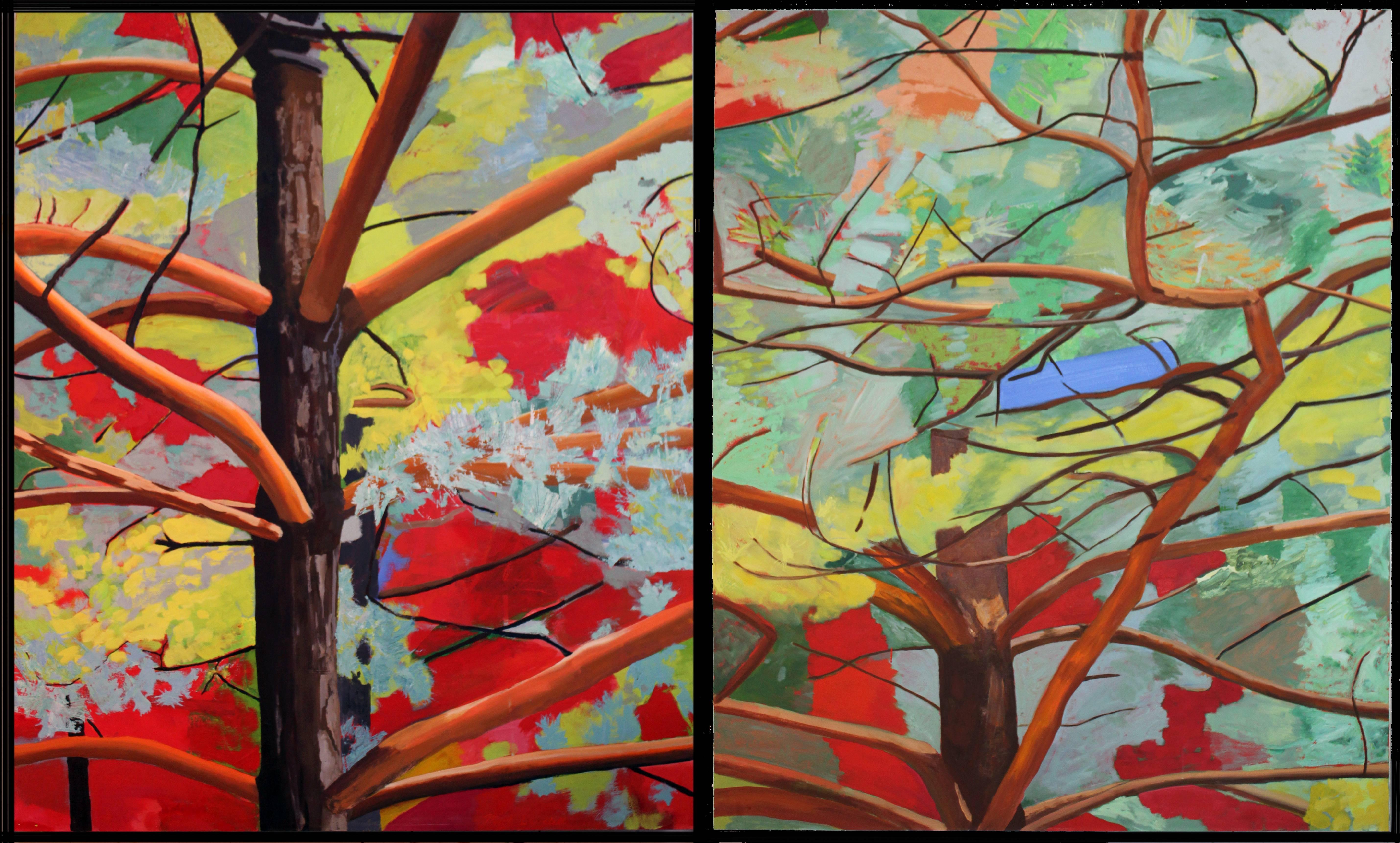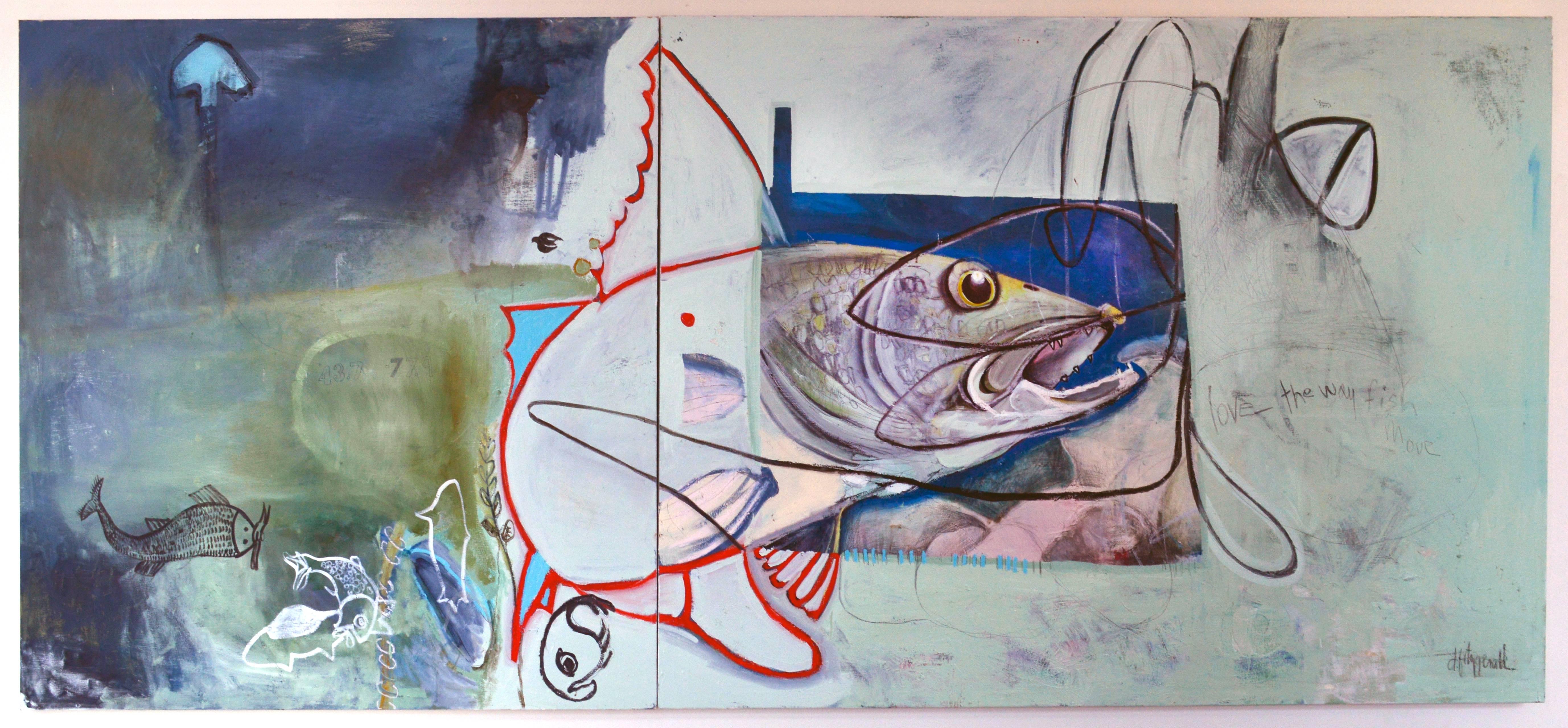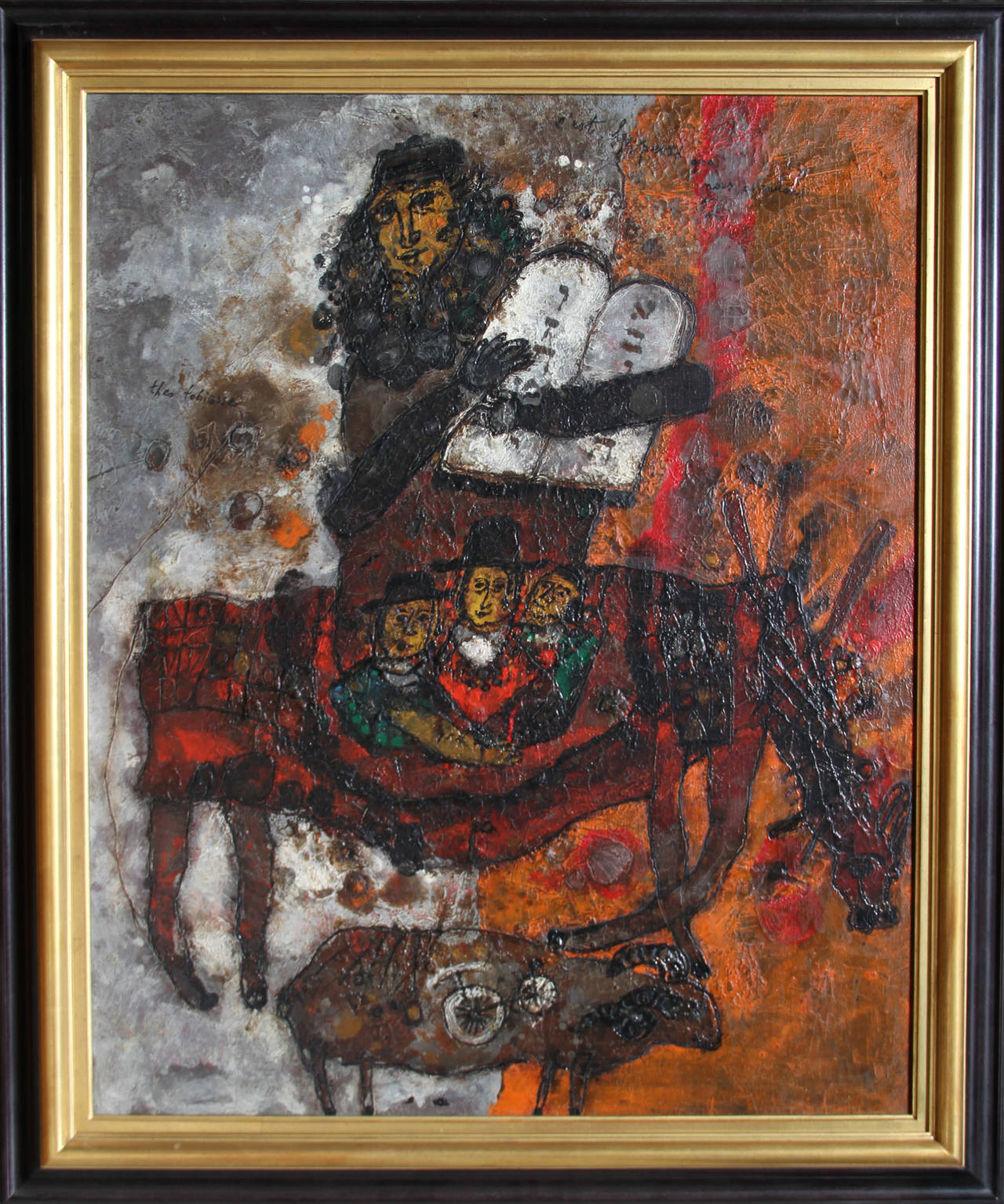Items Similar to Toujours la Vie Recommence
Want more images or videos?
Request additional images or videos from the seller
Edouard GoergToujours la Vie Recommence1958
1958
About the Item
Oil on canvas by Edouard Goerg (1893-1969), France, 1958. Life is always the same. Acquired in 2017 from the personal collection of Edouard Goerg. Measurements : with frame : 62.5x53.4 cm - 24.6x21 inches, without frame : 55x46 cm - 21.7x18.1 inches, format 10F. Signed "E.Goerg" (see photo).
Preserved by the painter, then by his family since his death in 1969, this painting appeared in 2017. Entitled "Always life begins again", it is a crepuscular work. Testamentary one could say, so much the statement which is made there is definitive. The fact that he kept it until his death tends to consolidate this vision. Far from the empty looks and death faces of the rebellious era of sarcastic expressionism, the terrifying and compassionate testimony of the Spanish war, and the post-WWII flower women, we are dealing here with a a form of reasonable abdication, but honest. This idea that although everything changes, nothing changes. Changed times, actors, ideas, the same comedy occupies the society. Having given up the idea of changing the latter, Goerg accepts the fact that the only alternative is to stay there or get lost. But stay afloat with his values, completely independent, whatever the cost is.
This work is similar to La Vie Recommence of 1935, reproduced on page 54 of Gaston Diehl's book devoted to the painter (Éditions de Clermont, 1947). On the latter, the artist depicts his vision of life, from birth to death, made of hope, fear, cruelty, resignation and fatality. 23 years later, Toujours La Vie Recommence shows us the road traveled by the painter. It is no longer a matter of denunciation, but ultimately of acceptance of reality and the difficulty of staying there yourself.
The admirer of Hieronymus Bosch gives us an inspired composition. The hand of God, the only expression of physical beauty in this work, comes down from heaven to give life. Symbolically, it holds an egg that dispenses the element from which the human protagonists find their birth, and in which they move and tangle more than they impose. Beautiful allegory of society. Four characters, two women and two men evolve in this societal marigot. The man in the foreground, ruddy face, evolves with ease. His body is supple, flexible, adaptable. The woman on the left observes him with admiration. Obviously, this man is in his place and causes rapture. The right man with massive shoulders and wrapped, shows a physical maladjustment to the activity he is doing. He struggles to stay afloat, his face expresses effort, even exhaustion. But he assumes. He does with what he has, with what he is. The other woman shows him the greatest indifference. What is not the case of the demonic archangel (recurrent in the works of Bosch) with the stunted body, who leads the dance and holds this character, we understand the painter, under his control as to have fun. As this character cannot change bodies, Goerg cannot change values. He does it with. Had he not said to the critic Roger Brielle: "Independents, sensitive and just men, that's what we must strive to stay in this world in disarray". Goerg will have come to narrative expressionism to give us a balance sheet allegory of his deep self and his condition.
Édouard Goerg is one of the major artists of his generation. Coming from a Champagne family, he was born in Sidney, Australia, in 1893, during a professional stay of his father. After passing through London, he arrives in Paris at the age of seven. At twenty, between 1913 and 1914, he studieds painting at the Académie Ranson with Maurice Denis and Paul Sérusier. He travels to Italy and India. Mobilized in 1914, he is sent to Artois, then to Argonne. From 1920, he exhibits at the Salon des Independants, then at the Salon d'Automne where he joins with Laboureur. At Berthe Weil, in 1924, he participates in the exhibitions of the Gromaire group, a prelude to a series of exhibitions in Paris (Berthe Weill, Bernheim Jeune), as in Brussels (Le Centaure). Goerg illustrates books including Table of the beyond by F.Boutet. In 1928, he meets Paul Guillaume who exhibits his works in Boston and the Art Institute of Chicago. He continues to show his works, satires of the bourgeois manners, at Bernheim Jeune, then at Lucie Krogh. In 1934, he travels to Belgium and Holland where he paints surrealist paintings that will be exhibited at Jeanne Castel. In 1935-1936, he meets Aragon, who opened the doors of the houses of the cultures created by the Association of Writers and Revolutionary Artists. The Spanish war and the Second World War mark it deeply. He must protect his daughter and his Jewish women against the pursuit of the Nazis. The latter will die by lack of care. In 1949, Goerg is appointed professor of Fine Arts and teaches at the Grande Chaumière. He is elected to the Academy of Fine Arts in 1965. He dies in 1969.
" His satirical verve is that of a Toulouse-Lautrec of the Roaring Twenties. Goerg instigates the world from which he comes, his ceremonial, morgue and the falsity of important people " (Michel Charzat, La jeune peinture française)
In the paintings of his early period he attacks the morality of post-war bourgeois society, and in that sense was similar to expressionist painters like Georg Grosz. The major works of this period are: Pirate (1922); Gourmand (1923); Bar (1923); Marriage (1924); Window (1924); Don Quixote (1925); and Good fortune (1925). He travels extensively, and in 1935 visits the museums of Holland, where he is deeply influenced by the works of Hieronymus Bosch and Bruegel. He then directs a series of paintings on the theme of the tragedy of the human condition, under the generic title: "eThis is how the world turns under the eye of the police".
After the Second World War, he savs his vitriolic commentary for his etchings, and in his paintings ceased to criticize real life and instead celebrated the evil charms of the flower-girls. He illustrates many books, including: Tales of Hoffmann, Picture of the Beyond by Frederick Boutet, Knock by Jules Romains, The Flowers of Evil by Charles Baudelaire, The Book of Job and Apocalypse of St. John by Sir Isaac Newton, who have all demonstrated his engraving skills. Asked about his art, he confesses that he had first wanted to try to unblock the "comedy of everyday forms". Essentially a painter of figures, he generally paints groups of feminine nudes; however, these nudes are often accompanied by conservatively dressed male spectators, who are the most enduring symbol of his first comic intentions. Nevertheless, the comedy is loaded with bitterness and sarcasm.
After several refusals, he is accepted at the Salon des Artistes Indépendants in 1922. His work then appears at the Salon d'Automne, at the Salon des Tuileries, at the Salon des Peintres Témoins of Their Time and at the Salon of the Society of Painters-Engravers, where he becomes honorary president from 1945 to 1958. He makes his first personal exhibition in Paris in 1925. After that, he exhibits regularly in France and abroad. There have been several retrospectives of his work, notably in 1988 at the Grand Palais in Paris and the Salon du Verney in Vichy. In 1949, he receives the very prestigious Hallmark prize for Nativity. In 1950 he receives the Lugano Prize for Engraving.
"In the mid-twenties, he developed his plastic code: canvases with a flat surface, a chromatic range that has brightened with phosphorescent blues and greens, a craft that wants to transcend the subject by intrinsic beauty. Goerg works with the patience of the alchemist his paste that he superimposes to obtain the sumptuousness of enamels. A pictorial magic unifies the different periods of the work" (Michel Charzat, La jeune peinture française)
- Creator:Edouard Goerg (1983-1969, French)
- Creation Year:1958
- Dimensions:Height: 24.41 in (62 cm)Width: 21.03 in (53.4 cm)Depth: 1.58 in (4 cm)
- Medium:
- Movement & Style:
- Period:
- Condition:
- Gallery Location:Saint Amans des cots, FR
- Reference Number:1stDibs: LU1088213326642
About the Seller
5.0
Vetted Seller
These experienced sellers undergo a comprehensive evaluation by our team of in-house experts.
1stDibs seller since 2018
34 sales on 1stDibs
- ShippingRetrieving quote...Ships From: Saint Amans des cots, France
- Return PolicyA return for this item may be initiated within 2 days of delivery.
More From This SellerView All
- Edith Desternes, The Church Notre-Dame de l'Assomption in Auvers-sur-Oise, 1920sLocated in Saint Amans des cots, FROil on canvas by Edith Desternes (1901-2000), France, 1920s. The Church Notre-Dame de l'Assomption in Auvers-sur-Oise. This church has been painted in 1890 by Vincent van Gogh. At first glance, one is struck by the strength of this work. Then, on examination, one is captivated by this depth of soul and technique. Edith Desternes uses a thick paint here where black, and dark colors, play a privileged role. Thus the contrast between the warm and cold tones, surrounded by black, create an intense luminosity reminiscent of stained glass windows from the Middle Ages. Georges Rouault is present in this powerful work. With frame : 87x66 cm - 34.25x26 inches ; without frame : 81x60 cm - 31.9x23.6 inches ; 25P Format. Signed "E. Desternes" lower right (see photo). On the back, we notice the pictorial material dropped by the artist, it is not a restoration. The condition is excellent ! Céline Édith Desternes was born in Paris on February 21, 1901. She was the daughter of Louis Desternes (1864-1936), professor at the Lycée...Category
1920s Expressionist Figurative Paintings
MaterialsCanvas, Oil
- DreamLocated in Saint Amans des cots, FROil on canvas by Madé Gourdon, France, 1960s. "Dream". with frame: 70x61 cm - without frame: 55x46 cm. 10F format. Signed "Madé Gourdon" in the lower left. In its frame Montparnasse....Category
1960s Expressionist Figurative Paintings
MaterialsBurlap, Oil, Canvas
- Amedee de La PATELLIERE, Eclipse with 4 Characters, 1928Located in Saint Amans des cots, FROil on canvas by Amedee de La PATELLIERE, France, 1928. Eclipse with four characters. With frame: 63x54 cm - 24.8x21.25 inches ; without frame: 41x33 cm - 16.15x13 inches. Format 6F....Category
1920s Expressionist Figurative Paintings
MaterialsCanvas, Oil
- Bories-en-Provence Village Near Gordes, Large Oil on CanvasLocated in Saint Amans des cots, FROil on canvas by Paul Clement (1906-), France, 1967. Bories-en-Provence near Gordes. Measurements : with frame: 106x87 cm - 41.7x34.25 inches, without frame: 100x81 cm - 39.4x31.9 in...Category
1960s Expressionist Figurative Paintings
MaterialsCanvas, Oil
- Edouard Goerg, Les 3 Brunes, Large Oil on Canvas, 1955By Edouard GoergLocated in Saint Amans des cots, FRLarge oil on canvas by Edouard GOERG (1893-1969), France, 1955. LES 3 BRUNES. With frame : 114x95cm - 44.9x37.4 inches ; without frame : 92.2x73 cm - 36.3x28.75 inches. Format 30F. S...Category
1950s Expressionist Figurative Paintings
MaterialsCanvas, Oil
- Paul Collomb, Paris, Eiffel Tower, Invalides, The Beautiful View, Oil on CanvasLocated in Saint Amans des cots, FROil on canvas by Paul Collomb (1921-2010), France, 1960s. The beautiful view. Measurements : with frame: 54.5x41.2 cm - 21.5x16.2 inches, without frame: 46x33 cm - 18.1x13 inches, fo...Category
1960s Expressionist Figurative Paintings
MaterialsCanvas, Oil
You May Also Like
- No Photos PleaseBy Todd WhiteLocated in Toronto, ON42" x 31" Unframed Original - Oil on Canvas Hand Signed by Todd White Todd white captures restaurant, night and Hollywood scenes with contrasting colors serving the viewer’s eyes a...Category
2010s Expressionist Figurative Paintings
MaterialsCanvas, Oil
- R. Schuenke 1950's PortraitLocated in San Francisco, CA1950's portrait painting signed Schuenke Oil on canvas We believe the artist is Robert Schuenke, but this is not confirmed.Category
20th Century Expressionist Figurative Paintings
MaterialsOil, Canvas
- HavenBy Mark LavatelliLocated in Buffalo, NYAn original oil on canvas diptych by American contemporary artist Mark Lavatelli created in 1996. 72" X 122"Category
1990s Expressionist Figurative Paintings
MaterialsCanvas, Oil
- They found the pike but it wasn’t aloneBy Dorothy FitzgeraldLocated in Buffalo, NYAn original oil, oil stick and charcoal diptych painting on canvas by Contemporary female artist Dorothy Fitzgerald. This monumental work measures 60" (h) x 120" (w) This work was featured in the recent exhibition of The Corridors Gallery at Hotel Henry...Category
2010s Expressionist Figurative Paintings
MaterialsCanvas, Mixed Media, Oil
- C'est le Passe que Nous AttendonsBy Théo TobiasseLocated in Long Island City, NYAn oil painting by Theo Tobiasse from 1967. An expressionist-style textural painting of intensely dark and vivid color palette. Inspired from the artist's personal experiences of the...Category
1960s Expressionist Figurative Paintings
MaterialsOil, Canvas
- Le triomphe de la mort, 2000, oil on canvas by Jean JansemBy Jean JansemLocated in Carouge GE, GEJean Jansem (1920-2013) Le triomphe de la mort, 2000 Huile sur toile Signée en bas à gauche et à droite 150 x 200 cm Bibliographie: Cette oeuvre est enregistrée dans les archives de l’Association des Amis de Jean Jansem. Figurera dans le catalogue critique de l’oeuvre de Jean Jansem actuellement en préparation par l’association des amis de Jean Jansem Historique: L’indigence d’après-guerre et la difficulté inhérente de trouver les matériaux adéquats et/ou habituels, telles les couleurs, très onéreuses alors, ont poussé les artistes figuratifs de l’après-guerre, en corrélation avec les préoccupations de l’époque, à redéfinir les paradigmes de la représentation. Il n’est plus question de chercher un sens mais bien pour les artistes d'étudier l’objet pour son intérêt formel, sa qualité intrinsèque. Le regard de l’artiste devient analytique et dépeint alors l’objet pour ce qu’il est et non plus pour son pouvoir évocateur ou symbolique. La nature morte n’est plus une invitation sensuelle à la ripaille, la pomme ou la pêche n’évoque aucune envie de croquer, la cruche aucune ivresse, la volaille...Category
Late 20th Century Expressionist Figurative Paintings
MaterialsCanvas, Oil





